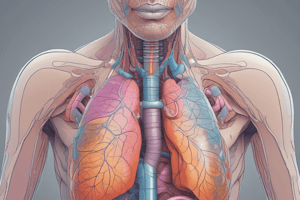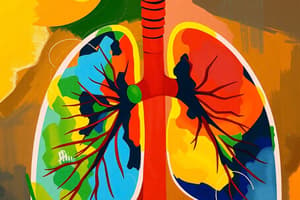Podcast
Questions and Answers
What percentage of carbon dioxide is transported as bicarbonate ions in the blood?
What percentage of carbon dioxide is transported as bicarbonate ions in the blood?
- 7%
- 23%
- 70% (correct)
- 50%
What is the normal tidal volume (TV) for an average adult at rest?
What is the normal tidal volume (TV) for an average adult at rest?
- 750 ml
- 1000 ml
- 500 ml (correct)
- 250 ml
Which volume measures the amount of air that can be forcibly inhaled beyond normal breathing?
Which volume measures the amount of air that can be forcibly inhaled beyond normal breathing?
- Residual volume
- Inspiratory reserve volume (correct)
- Expiratory reserve volume
- Tidal volume
What role do central and peripheral chemoreceptors play in the control of respiration?
What role do central and peripheral chemoreceptors play in the control of respiration?
Which of the following statements about vital capacity (VC) is true?
Which of the following statements about vital capacity (VC) is true?
What is the primary function of the diaphragm during breathing?
What is the primary function of the diaphragm during breathing?
During external respiration, which statement is correct regarding oxygen movement?
During external respiration, which statement is correct regarding oxygen movement?
What percentage of oxygen in the blood is carried bound to hemoglobin?
What percentage of oxygen in the blood is carried bound to hemoglobin?
In internal respiration, what occurs as oxygen moves from the systemic capillaries?
In internal respiration, what occurs as oxygen moves from the systemic capillaries?
What happens to carbon dioxide during pulmonary gas exchange?
What happens to carbon dioxide during pulmonary gas exchange?
Which muscle is primarily responsible for inhalation?
Which muscle is primarily responsible for inhalation?
What occurs during exhalation when the diaphragm relaxes?
What occurs during exhalation when the diaphragm relaxes?
Which breathing pattern is characterized by rapid breathing?
Which breathing pattern is characterized by rapid breathing?
Which of the following statements is true about pulmonary ventilation?
Which of the following statements is true about pulmonary ventilation?
What is the primary function of external intercostal muscles during inhalation?
What is the primary function of external intercostal muscles during inhalation?
During which stage of respiration does gas exchange primarily occur?
During which stage of respiration does gas exchange primarily occur?
What role do the internal intercostal muscles play during forced expiration?
What role do the internal intercostal muscles play during forced expiration?
What physiological change occurs in the lungs during inhalation?
What physiological change occurs in the lungs during inhalation?
Flashcards
Diaphragmatic breathing
Diaphragmatic breathing
Using the diaphragm to move air into and out of the lungs.
External respiration
External respiration
Gas exchange between the lungs and the blood.
Internal respiration
Internal respiration
Gas exchange between the blood and the tissues.
Oxygen transport in blood
Oxygen transport in blood
Signup and view all the flashcards
Respiratory membrane
Respiratory membrane
Signup and view all the flashcards
CO2 Transport
CO2 Transport
Signup and view all the flashcards
Respiratory Volumes
Respiratory Volumes
Signup and view all the flashcards
Respiratory Center
Respiratory Center
Signup and view all the flashcards
Vital Capacity
Vital Capacity
Signup and view all the flashcards
Chemoreceptors
Chemoreceptors
Signup and view all the flashcards
Pulmonary Ventilation
Pulmonary Ventilation
Signup and view all the flashcards
Inhalation (Inspiration)
Inhalation (Inspiration)
Signup and view all the flashcards
Exhalation (Expiration)
Exhalation (Expiration)
Signup and view all the flashcards
Alveolar Pressure
Alveolar Pressure
Signup and view all the flashcards
Diaphragm
Diaphragm
Signup and view all the flashcards
Intrapleural Pressure
Intrapleural Pressure
Signup and view all the flashcards
Eupnea
Eupnea
Signup and view all the flashcards
Dyspnea
Dyspnea
Signup and view all the flashcards
Study Notes
Carbon Dioxide Transport
- Approximately 90% of carbon dioxide in the blood is transported as bicarbonate ions (HCO3-)
Tidal Volume
- The normal tidal volume (TV) for an average adult at rest is approximately 500 mL.
Inspiratory Reserve Volume
- Inspiratory reserve volume (IRV) measures the amount of air that can be forcibly inhaled beyond normal breathing.
Chemoreceptors and Respiration
- Central chemoreceptors in the medulla oblongata monitor changes in cerebrospinal fluid (CSF) pH, primarily due to CO2 levels.
- Peripheral chemoreceptors located in the carotid and aortic bodies detect changes in blood oxygen (O2) levels and pH.
Vital Capacity
- Vital capacity (VC) represents the maximum amount of air that can be exhaled after a maximal inhalation. It is the sum of tidal volume, inspiratory reserve volume, and expiratory reserve volume.
Diaphragm Function
- The primary function of the diaphragm during breathing is to contract for inhalation, pushing air into the lungs.
External Respiration
- Oxygen (O2) moves from the alveoli (tiny air sacs in the lungs) to the pulmonary capillaries (blood vessels) due to a higher partial pressure of O2 in the alveoli.
Oxygen Transport
- Approximately 98.5% of oxygen in the blood is carried bound to hemoglobin within red blood cells.
Internal Respiration
- Oxygen (O2) moves from the systemic capillaries (blood vessels that supply tissues) into the interstitial fluid and then into cells due to a higher partial pressure of O2 in the capillaries.
Carbon Dioxide Exchange
- Carbon dioxide (CO2) diffuses from the tissues into the blood, and then from the blood into the alveoli due to a higher partial pressure of CO2 in the blood.
Inhalation Muscles
- The diaphragm is the primary muscle responsible for inhalation.
- Accessory muscles, such as the external intercostal muscles, assist in forceful inhalation.
Exhalation Mechanics
- Relaxation of the diaphragm and the external intercostal muscles allows the chest cavity to recoil.
- This increase in pressure in the lungs causes air to be expelled.
Tachypnea
- Tachypnea refers to rapid breathing.
Pulmonary Ventilation
- Pulmonary ventilation involves the movement of air into and out of the lungs.
- This process is driven by pressure gradients created by changes in lung volume.
External Intercostal Muscles
- External intercostal muscles assist in inhalation by pulling the ribs upward and outward.
- This action increases the volume of the thoracic cavity.
Gas Exchange Stage
- Gas exchange occurs primarily during the alveolar stage of respiration, specifically within the alveoli.
Internal Intercostal Muscles
- Internal intercostal muscles assist in forceful expiration by pulling the ribs downwards and inwards.
- This decreases the thoracic cavity volume.
Lung Volume Change
- During inhalation, the lung volume increases as the diaphragm flattens and the rib cage expands.
- These actions create negative pressure in the lungs that draws air in.
Studying That Suits You
Use AI to generate personalized quizzes and flashcards to suit your learning preferences.
Related Documents
Description
Test your knowledge on key concepts of respiratory physiology, including gas exchange, tidal volumes, and the role of chemoreceptors. This quiz covers essential topics related to how our body manages oxygen and carbon dioxide during breathing processes.




